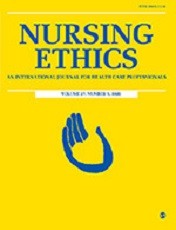Ann-Marie Begley

Abstract
Euthanasia has once again become headline news in the UK, with the announcement by Dr Michael Irwin, a former medical director of the United Nations, that he has helped at least 50 people to die, including two between February and July 1997. He has been quoted as saying that his ‘conscience is clear’ and that the time has come to confront the issue of euthanasia.
For the purposes of this article, the term ‘beneficent voluntary active euthanasia’ (BVAE) will be used: beneficent from the prima facie principle of beneficence, to do good, and voluntary to indicate that this must be carried out at the request of a competent client. This implies adherence to another prima facie principle, that of respect for autonomy. Active implies that something is done or given with the intention of hastening death. The word euthanasia itself simply means ‘good death’.
This article examines the moral positions of two nurses and one junior doctor towards the subject of BVAE and an attempt is made to represent the main conflicting moral positions. The central arguments against BVAE and counterarguments are presented. The conclusion reached is that consenting adults should not be prevented from availing themselves of BVAE if another consenting adult (a medical doctor) is available and capable of carrying out their wishes. This being the case, it is suggested that BVAE should be available as an option in hospices and in the community.
The aims of this article are: to generate debate among professionals; to present a three-way discussion that might be useful as a focus for educational purposes, particularly at undergraduate level; to challenge professionals to confront the issue of euthanasia; and to plead the case of those who request assistance in exercising autonomy by gaining control over their own deaths.
Begley A-M. Beneficent Voluntary Active Euthanasia: A Challenge to Professionals Caring for Terminally Ill Patients. Nurs Ethics. 1998;5(4):294-306.